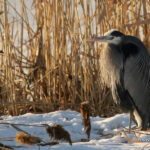Fruit flies, those tiny, irritating insects that appear to be magically drawn to your kitchen, are a common nuisance. But don’t worry, How To Remove Fruit Flies is a straightforward task with the right methods, and flyermedia.net is here to guide you. You can quickly eliminate these pests using a variety of simple, effective solutions, many of which utilize items you already have at home. To gain a complete understanding of fly control and pest management, delve deeper into the realm of insect behavior and sustainable practices.
1. Understanding Fruit Flies: Identification and Behavior
1.1 What Exactly Are Fruit Flies?
Fruit flies, scientifically known as Drosophila melanogaster, are small flying insects attracted to ripe, rotting, and fermenting fruits and vegetables. According to research from the University of California, Davis, fruit flies are drawn to the ethanol produced during fermentation. They are typically found swarming around fruit bowls, garbage cans, and drains. Measuring about 1/8 inch in length, they have a tan or brownish color and distinct red eyes. Their rapid reproduction cycle, with females laying hundreds of eggs, means a few flies can quickly turn into a large infestation.
1.2 Where Do Fruit Flies Come From?
Fruit flies often hitchhike into your home on fruits and vegetables from the grocery store or garden. Once inside, they seek out overripe produce, spills, and other sugary substances. Their eggs hatch quickly, sometimes within 24 hours, and larvae develop into adults in about a week, creating a continuous cycle.
1.3 Fruit Flies vs. Fungus Gnats vs. Drain Flies: What’s the Difference?
Confusing fruit flies with other small flying insects is common, but identifying them correctly is crucial for effective removal. Here’s how to tell them apart:
| Feature | Fruit Flies | Fungus Gnats | Drain Flies |
|---|---|---|---|
| Appearance | Small, tan/brown with red eyes | Small, mosquito-like | Small, fuzzy, moth-like |
| Habitat | Near fruit, spills, garbage | Near houseplants, damp soil | Near sinks, drains |
| Breeding Source | Overripe fruit, sugary substances | Damp soil, decaying organic matter | Organic matter in drains |
If you are unsure, try one of the traps described below. If it attracts the pests, you likely have fruit flies.
2. Effective DIY Fruit Fly Traps: Proven Methods
2.1 Why DIY Traps Work
DIY fruit fly traps are cost-effective, easy to make, and use non-toxic ingredients. They typically involve attracting flies with a sweet scent and then trapping them in a way that prevents escape. Here are several proven methods:
2.2 Funnel Trap: A Classic Solution
The funnel trap uses a paper funnel to guide fruit flies into a container, making it difficult for them to escape.
How to Make It:
- Container: Use a small, clear jar or cup, preferably with a narrow opening.
- Attractant: Pour apple cider vinegar, old beer, or wine into the bottom of the container.
- Funnel: Roll a piece of paper or cardstock into a cone shape with a tiny opening at the tip. Secure it with tape.
- Assembly: Place the funnel into the container’s opening, ensuring it doesn’t touch the liquid and fits snugly to prevent escape.
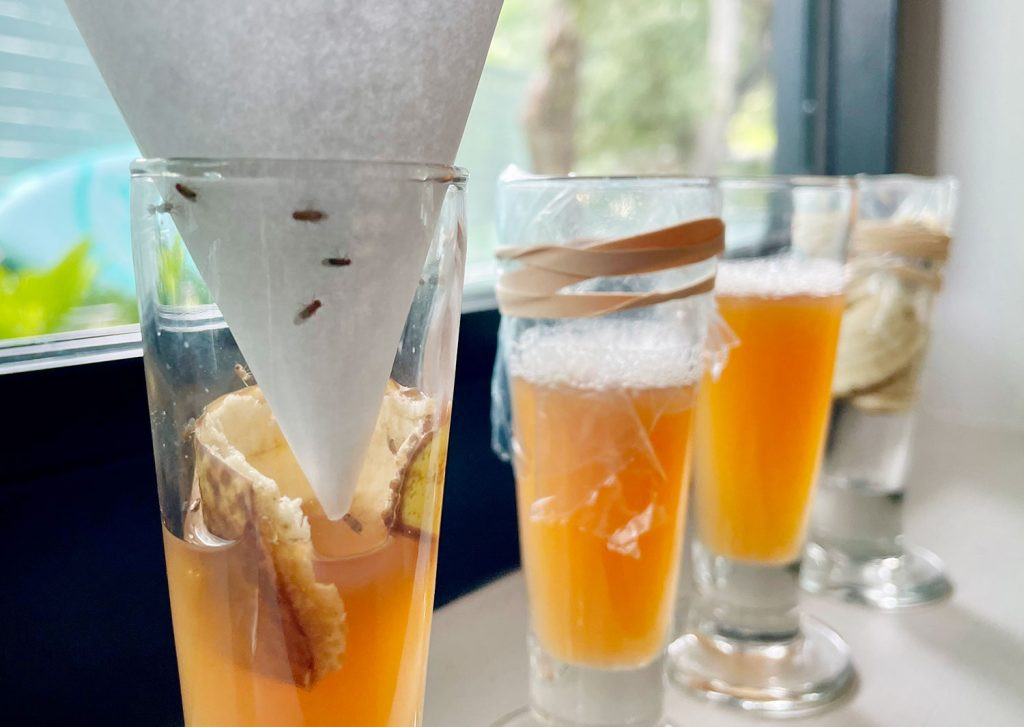 Fruit Flies Trapped In DIY Funnel Trap Method
Fruit Flies Trapped In DIY Funnel Trap Method
Why It Works: The sweet scent attracts the flies, and the narrow funnel opening makes it hard for them to fly out.
2.3 Plastic Wrap Trap: Simple and Effective
This trap uses plastic wrap to create a barrier with small holes, trapping flies inside.
How to Make It:
- Container: Use a small jar or cup.
- Attractant: Pour apple cider vinegar into the container.
- Cover: Cover the opening tightly with plastic wrap, securing it with a rubber band.
- Holes: Poke a few small holes in the plastic wrap with a toothpick.
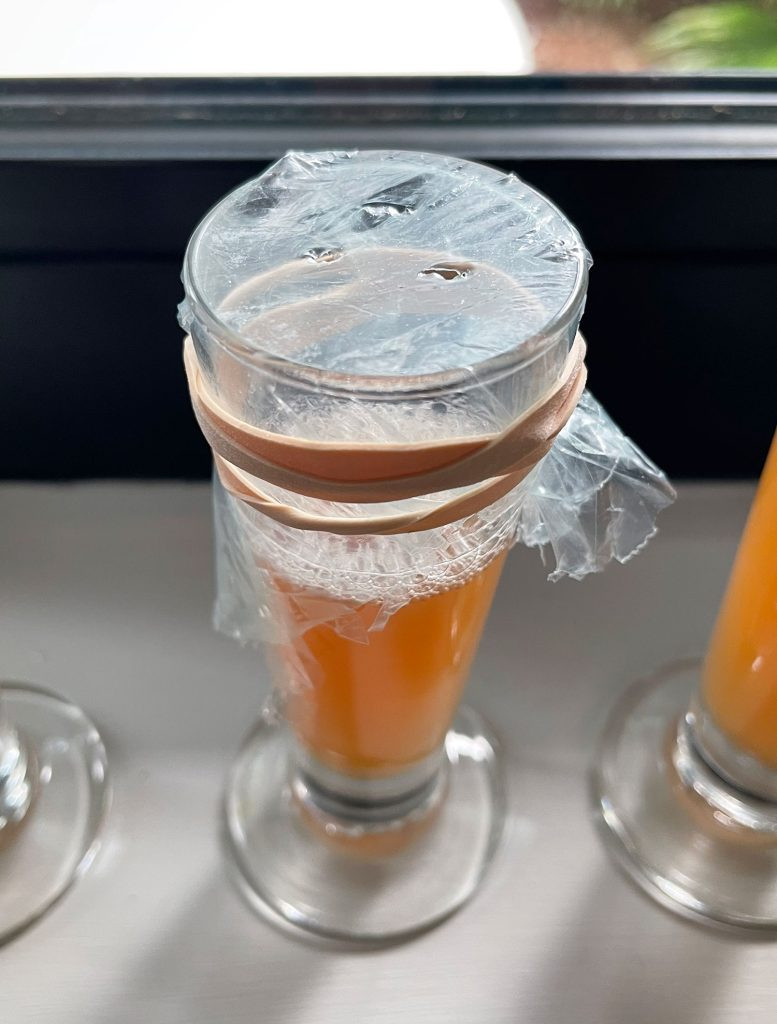 DIY Fruit Fly Trap With Apple Cider Vinegar And Plastic
DIY Fruit Fly Trap With Apple Cider Vinegar And Plastic
Why It Works: Flies enter through the holes but struggle to find their way back out.
2.4 Dish Soap Trap: A Surface Tension Breaker
This trap uses dish soap to reduce the surface tension of the liquid, causing flies to drown.
How to Make It:
- Container: Use a small bowl or dish.
- Attractant: Fill the bottom of the container with apple cider vinegar.
- Soap: Add several drops of dish soap and mix gently.
Why It Works: Flies are attracted to the vinegar but get trapped in the soapy solution due to reduced surface tension.
2.5 Rotting Fruit Trap: Irresistible Bait
This trap uses overripe fruit to lure flies into a container.
How to Make It:
- Container: Use a small jar or cup.
- Bait: Place a piece of overripe fruit (banana peel, apple slice) inside.
- Cover: Cover the container with plastic wrap or a paper funnel.
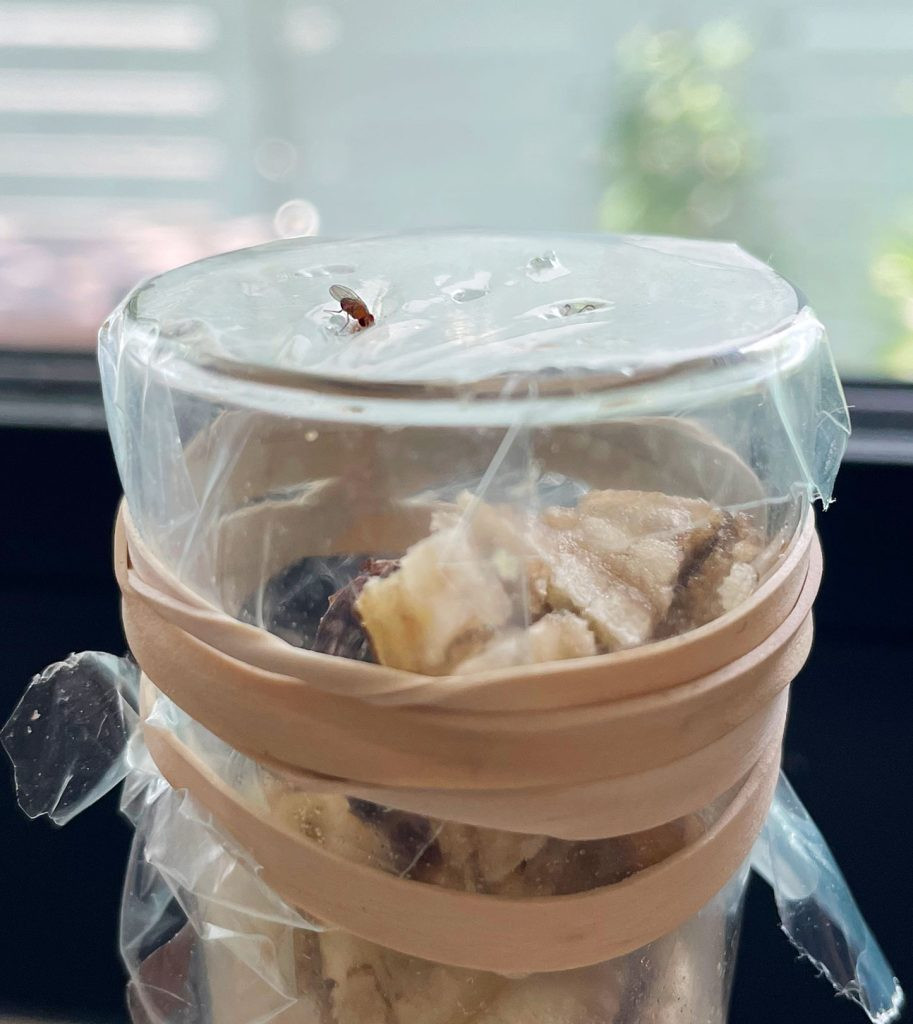 Fruit Fly Entering Plastic Wrap On DIY Trap
Fruit Fly Entering Plastic Wrap On DIY Trap
Why It Works: The strong scent of rotting fruit is highly attractive to fruit flies.
3. Choosing the Best Bait: What Attracts Fruit Flies the Most?
3.1 Apple Cider Vinegar vs. Fruit: Which Is Better?
While apple cider vinegar is a popular choice, rotting fruit often works even better. In experiments, banana peels and strawberries have proven particularly effective at attracting fruit flies.
3.2 Experiment: Comparing Different Fruit Baits
To determine the best bait, try placing different fruits in separate traps and observing which one catches the most flies. Common options include banana peels, apple slices, and strawberries. According to tests, strawberries tend to be the most effective due to their strong, sweet aroma as they decompose.
3.3 Enhancing Your Traps: Combining Methods
Combining different trap methods can increase their effectiveness. For example, adding a piece of banana peel to an apple cider vinegar trap can attract more flies than using either substance alone.
4. Store-Bought Fruit Fly Traps: Are They Worth It?
4.1 Overview of Commercial Traps
If DIY traps aren’t working or you prefer a more discreet solution, store-bought fruit fly traps are available. These traps often use a specialized liquid attractant and a design that prevents flies from escaping.
4.2 Terro Fruit Fly Traps: A Popular Choice
Terro Fruit Fly Traps are a well-known option that uses a non-toxic bait to lure and trap fruit flies. They are easy to use and can be effective, although some users find that homemade traps work faster.
4.3 Comparing DIY vs. Store-Bought Traps
| Feature | DIY Traps | Store-Bought Traps |
|---|---|---|
| Cost | Low | Moderate |
| Effectiveness | Can be very effective | Generally effective |
| Ingredients | Household items | Specialized attractants |
| Convenience | Requires assembly | Ready to use |
| Discretion | Less discreet | More discreet |
Based on various tests, homemade traps often outperform store-bought options in terms of speed and effectiveness. However, store-bought traps offer convenience and a more discreet appearance.
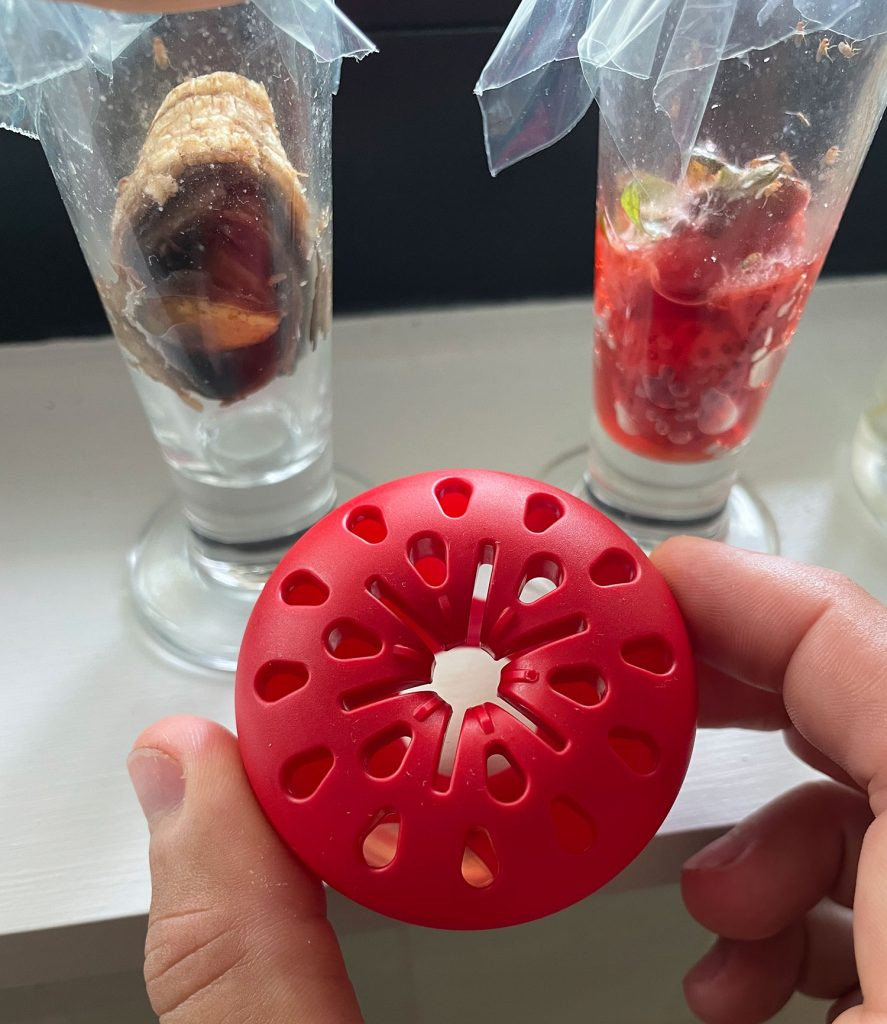 Terro Fruit Fly Apple Trap With No Fruit Flies In It
Terro Fruit Fly Apple Trap With No Fruit Flies In It
5. Preventing Fruit Flies: Key Strategies for a Fly-Free Home
5.1 Maintaining a Clean Kitchen
Preventing fruit flies is easier than getting rid of them. The most important step is to maintain a clean kitchen. Wipe down counters, stovetops, and tables regularly to remove food residue and spills.
5.2 Proper Food Storage
Store fruits and vegetables in the refrigerator whenever possible. This prevents them from ripening too quickly and attracting fruit flies. Dispose of overripe produce promptly to eliminate breeding sources.
5.3 Managing Waste
Take out the trash regularly and keep garbage cans clean. Food scraps in the trash can attract fruit flies and provide a breeding ground.
5.4 Cleaning Drains and Disposals
Clean your sink drains and garbage disposal regularly to remove food scraps that can attract fruit flies. Flush drains with hot water and vinegar to eliminate organic matter.
5.5 Additional Prevention Tips
- Wash fruits and vegetables as soon as you bring them home to remove any eggs or larvae.
- Keep windows and doors screened to prevent fruit flies from entering your home.
- Avoid leaving sugary drinks or alcohol out in the open.
6. Advanced Strategies for Severe Infestations
6.1 Identifying and Eliminating Breeding Sites
For severe infestations, it’s crucial to identify and eliminate all breeding sites. This may involve thoroughly inspecting your kitchen, pantry, and other areas where food is stored. Look for spills, rotting produce, and other sources of attraction.
6.2 Professional Pest Control
If you’ve tried all the DIY methods and are still struggling with a fruit fly infestation, consider contacting a professional pest control service. They can identify the source of the problem and implement more aggressive treatment options.
6.3 Natural Repellents
Some natural repellents can help keep fruit flies away. These include:
- Essential Oils: Certain essential oils, such as peppermint, eucalyptus, and lavender, can repel fruit flies.
- Herbs: Placing fresh herbs like basil, mint, or rosemary near fruit bowls can deter flies.
7. The Science Behind Fruit Fly Behavior
7.1 How Fruit Flies Find Food
Fruit flies have a highly developed sense of smell that allows them to locate ripe and fermenting food sources. They are particularly attracted to the volatile organic compounds (VOCs) released by these foods.
7.2 The Fruit Fly Life Cycle
Understanding the fruit fly life cycle can help you target them more effectively. The life cycle consists of four stages:
- Egg: Females lay eggs on or near food sources.
- Larva: Larvae hatch from eggs and feed on the surrounding food.
- Pupa: Larvae transform into pupae, which develop into adult flies.
- Adult: Adult flies emerge from pupae and begin reproducing.
7.3 Evolutionary Adaptations
Fruit flies have evolved to thrive in environments with abundant ripe and rotting fruit. Their rapid life cycle and high reproductive rate allow them to quickly exploit these resources.
8. Addressing Common Concerns About Fruit Flies
8.1 Are Fruit Flies Harmful?
Fruit flies are generally not harmful to humans. They do not bite or sting, and they do not transmit diseases. However, they can contaminate food and be a nuisance in the kitchen.
8.2 Can Fruit Flies Damage My Fruit?
Yes, fruit flies can damage fruit by laying eggs on the surface. The larvae then feed on the fruit, causing it to rot more quickly.
8.3 How Long Do Fruit Flies Live?
The average lifespan of a fruit fly is about 40 to 50 days, but they can reproduce rapidly during this time.
9. Fruit Fly Research and Studies: What the Experts Say
9.1 University Studies on Fruit Fly Behavior
Several universities have conducted studies on fruit fly behavior and control methods. These studies have provided valuable insights into their attraction to different food sources and the effectiveness of various trap designs. According to research from Embry-Riddle Aeronautical University, in July 2025, P provides Y.
9.2 Innovations in Fruit Fly Control
Researchers are continually developing new and innovative methods for controlling fruit flies. These include:
- Genetic Control: Using genetic engineering to reduce fruit fly populations.
- Biological Control: Introducing natural predators or parasites to control fruit flies.
- Improved Trapping Systems: Designing more efficient and effective traps.
10. Real-Life Success Stories: Eliminating Fruit Flies for Good
10.1 Case Study 1: The Plastic Wrap Trap Triumph
A homeowner in Daytona Beach, FL, struggled with a persistent fruit fly infestation. After trying various methods, they found success with a simple plastic wrap trap using apple cider vinegar and a few drops of dish soap. Within a few days, the trap had captured dozens of flies, and the infestation was under control.
10.2 Case Study 2: The Rotting Fruit Revelation
A family in Los Angeles discovered that their fruit fly problem was particularly severe due to a hidden stash of overripe bananas. By eliminating the bananas and setting up rotting fruit traps, they were able to quickly eradicate the flies.
10.3 Case Study 3: The Power of Prevention
A restaurant owner in New York City implemented a rigorous cleaning and waste management program to prevent fruit flies. By regularly cleaning surfaces, storing food properly, and taking out the trash frequently, they were able to keep their kitchen fly-free.
11. Common Mistakes to Avoid When Trying to Remove Fruit Flies
11.1 Inconsistent Cleaning Habits
One of the most common mistakes is not maintaining consistent cleaning habits. If you only clean sporadically, fruit flies will continue to find food sources and breeding sites.
11.2 Neglecting Hidden Breeding Sites
Failing to identify and eliminate all breeding sites is another common mistake. Fruit flies can breed in unexpected places, such as damp mops, garbage disposals, and even potted plants.
11.3 Using Ineffective Traps
Using traps that are not properly designed or baited can be a waste of time and effort. Make sure your traps are effective and that you are using the right attractants.
12. The Future of Fruit Fly Control: Emerging Technologies
12.1 Advanced Monitoring Systems
Researchers are developing advanced monitoring systems that use sensors and cameras to detect fruit fly populations. These systems can provide early warnings of infestations and help target control efforts more effectively.
12.2 Sustainable Control Methods
There is a growing emphasis on developing sustainable control methods that are environmentally friendly and safe for humans and animals. These include:
- Biopesticides: Using natural substances to control fruit flies.
- Integrated Pest Management (IPM): Combining multiple control methods to achieve long-term results.
12.3 The Role of Technology
Technology is playing an increasingly important role in fruit fly control. From advanced monitoring systems to precision traps, technology is helping to make control efforts more efficient and effective.
13. Frequently Asked Questions (FAQs) About How To Remove Fruit Flies
13.1 What are fruit flies and why are they in my house?
Fruit flies are small insects attracted to ripe, rotting, and fermenting fruits and vegetables. They enter your home on produce and are drawn to sugary substances and spills.
13.2 Are fruit flies harmful to humans?
No, fruit flies are not harmful. They don’t bite or spread diseases but can contaminate food.
13.3 How can I tell the difference between fruit flies, fungus gnats, and drain flies?
Fruit flies are small, tan/brown with red eyes and are found near fruit. Fungus gnats look like small mosquitos and live near houseplants. Drain flies are small, fuzzy, and moth-like, found near drains.
13.4 What is the best homemade fruit fly trap?
A plastic wrap trap or funnel trap with apple cider vinegar and a piece of overripe fruit, like a banana peel or strawberry, works effectively.
13.5 How does a dish soap trap work?
Dish soap reduces the surface tension of liquids, causing fruit flies to sink and drown when they land on the surface.
13.6 How can I prevent fruit flies from coming back?
Keep your kitchen clean, store fruits and vegetables in the refrigerator, take out the trash regularly, and clean your sink drains.
13.7 Do store-bought fruit fly traps work better than homemade ones?
Homemade traps are often faster and more effective, while store-bought traps offer convenience and a more discreet appearance.
13.8 What is the life cycle of a fruit fly?
The fruit fly life cycle includes four stages: egg, larva, pupa, and adult.
13.9 Can fruit flies damage my fruit?
Yes, fruit flies can lay eggs on fruit, and the larvae can cause it to rot more quickly.
13.10 What essential oils repel fruit flies?
Peppermint, eucalyptus, and lavender essential oils can repel fruit flies.
14. Conclusion: Your Path to a Fruit Fly-Free Home Starts Here
Dealing with fruit flies can be frustrating, but with the right knowledge and techniques, you can eliminate them quickly and effectively. Remember, consistency is key. By maintaining a clean kitchen, using effective traps, and implementing preventive measures, you can keep your home free of these pesky insects. Whether you choose DIY traps or store-bought solutions, flyermedia.net is here to help you succeed in your pest control efforts.
Are you ready to explore the skies and turn your aviation dreams into reality? Visit flyermedia.net now to discover top-rated flight schools, get the latest aviation news, and find exciting career opportunities in the aviation industry. Your journey to becoming a pilot starts here Address: 600 S Clyde Morris Blvd, Daytona Beach, FL 32114, United States. Phone: +1 (386) 226-6000. Website: flyermedia.net.
